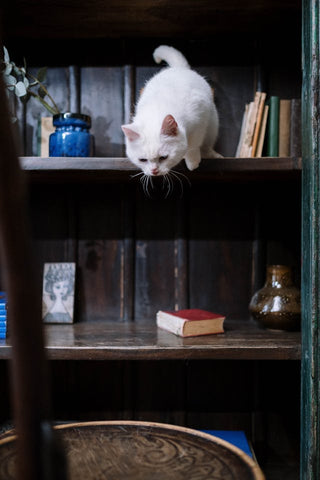
Cats are magical. Anybody who has ever cherished a cat already is aware of that. However have they got particular powers?
One of many seemingly mystical skills attributed to cats is their obvious means to land on their toes regardless of which manner they fall, and regardless of the peak from which they fall.
Is it true? Do cats land on their toes? And do they at all times land on their toes?
Spoiler alert: cats do have a particular, innate means to twist themselves right-side-up throughout a fall, that appears to defy the legal guidelines of physics. And there are documented instances of cats surviving falls from loopy, loopy heights.
Let’s discuss this particular means, and in addition a cat’s distinctive anatomy that may make not simply turning upright throughout a fall potential, however surviving an enormous fall potential, too.
(Do cats actually have 9 lives? Learn this publish to search out out!)
Tales abound of cats surviving falls from heights that will most definitely kill a human. Listed here are some examples:
Six-year-old Gizmo fell 12 tales from this Manhattan condominium constructing, struggling solely minor accidents, together with a chipped tooth.[1]
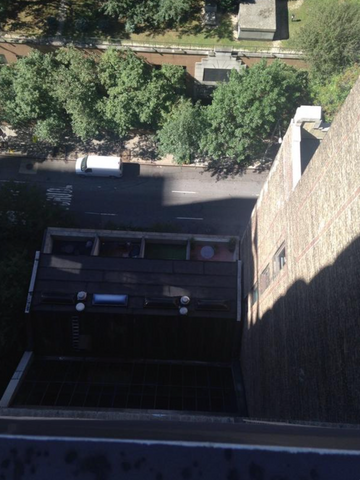
Eight-year-old Sasha Fierce, a long-haired orange cat from Virginia, jumped from or fell off a 15th-floor condominium balcony, and survived with only a scratched cornea from mulch that had gotten into her eye.[2]
And this black cat from Chicago was caught on video saving himself from a burning constructing by leaping 5 tales, and casually sauntering off afterwards.
Falling cats have been puzzling scientists because the late 1800s, at the least. Nobody was ever stunned that cats, daredevils that they’re, would fall. However it was odd how they at all times managed to flip themselves over, mid-fall, in order that they landed toes first.
Even within the 1800s, scientists understood that this means appeared to defy a specific regulation of physics referred to as “conservation of angular momentum.”
Conservation of angular momentum mainly says that objects that aren’t spinning can’t begin spinning on their very own. Some exterior power must be utilized to an object to make it spin.[3] In different phrases, cats can’t simply flip, mid-air, with out one thing flipping them.
Within the 1800s, individuals believed that cats added this power themselves, by pushing off of no matter floor they began out on, earlier than falling.[4]
Then alongside got here physicist Etienne-Jules Marey in 1894 along with his chronophotographic digital camera, to show them unsuitable. Chronophotography was a photographic approach that was used throughout the Victorian period to check locomotion in animals and people.[5]
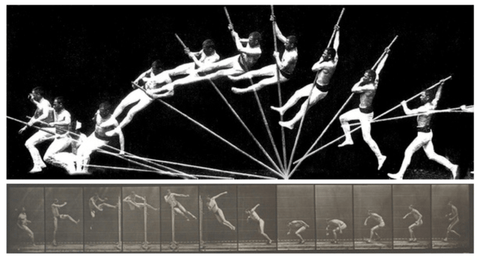
Marey’s collection of 60 pictures of a dropped-upside-down cat, present that cats don’t push off. They fall straight down, with their backs dealing with the bottom for a number of surprising milliseconds, earlier than magically flipping to land feet-first.

However how?
It wasn’t till 1969 that the issue was really solved.
Let’s put the physics apart for a second.
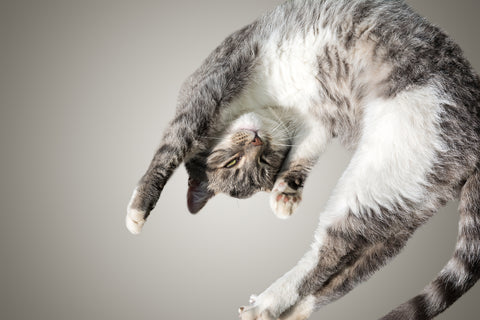
Cats do appear to have an uncanny means to know which manner is up it doesn’t matter what manner they begin out falling. It’s referred to as the self-righting reflex, and it occurs robotically, due to a cat’s vestibular system.
The vestibular system is made up of fluid-filled canals within the interior ear, and nerve cells and receptors that talk on to part of the mind on the high of the spinal wire. Because the fluid strikes within the canals, it offers details about the place of a cat’s head relative to gravity.[6]
The cat’s mind responds to this info by sending indicators to muscle groups to vary the place of the cat’s head and physique.
If a cat falls, this righting reflex kicks in involuntarily and instantaneously to reorient the cat to right-side-up.
Are cats the one animals with a self-righting reflex?
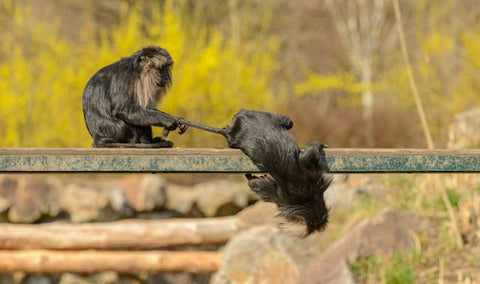
No. A number of animals together with guinea pigs, rats, monkeys, and even lizards and a few bugs have the flexibility to reorient themselves in a fall.[7] However few, if any, animals are as profitable at it as cats, due to their distinctive physiology.
Cats’ our bodies are so particular that their means to flip themselves over and survive a fall is known. I’ll talk about what makes them so extraordinary within the subsequent part.
Even people have righting reflexes, however we are usually extra profitable utilizing them on land. Our righting reflexes assist maintain our heads and our bodies in alignment with one another and with gravity, to maintain us from shedding our stability and toppling over.
However people don’t fare in addition to cats in falls.
Why are cats so good at flipping themselves over?
There are a number of the explanation why cats are so good at reorienting themselves mid-flight in a fall, and we, and guinea pigs, and different animals are simply not.
Cats have unbelievably versatile spines

Cat spines are a marvel of nature. They’ve loosely related vertebra with unusually elastic disks between them, permitting cats to be the true acrobats and contortionists of the animal kingdom.
Cat even have highly effective muscle groups surrounding their spines, permitting them to take full benefit of that flexibility. By extending and flexing their backs whereas operating, cats can attain speeds of as much as 30 MPH, and leap as much as 9 instances their very own peak from a sitting begin.[8]
Sturdy muscle groups round a supremely versatile backbone make it potential for cats to twist themselves right-side-up lightning-quick in a fall.
Cats have free-floating shoulder blades and tiny collarbones
Human shoulder blades are related to different bones, whereas cat shoulder blades are hooked up solely by muscle.
People even have lengthy collarbones, whereas cats actually don’t have any collarbones in any respect. They’ve miniscule clavicles buried close to their shoulders, however these don’t hook up with something.
Free-floating shoulder blades and tiny, untethered collarbones permit cats to squeeze into tight areas.
They usually additionally make cat our bodies further twisty and versatile in a fall.

Again to physics.
So, we all know that cats can determine which manner is up mid-fall, due to their self-righting reflex. And we all know that cats have superb our bodies that may twist and switch in a split-second when they should.
However how do cats overcome the conservation of angular momentum physics downside of a falling object?
Nobody figured it out till 1969, and by then, quite a lot of cats had been, sadly, dropped and thrown out of home windows within the title of science.
In a scientific paper entitled, “A dynamical rationalization of the falling cat phenomenon”[9] scientists defined that cats protect the legal guidelines of Newtonian physics by twisting their higher our bodies in a single route and their decrease our bodies in the other way.
Think about a peppermill.
Reverse rotations lead to a net-zero change in angular momentum.
All of the physicists are comfortable.
So, how precisely do cats twist themselves right-side up?
Cats seem to beat physics by dividing their our bodies into two elements and twisting them away from one another. However how does this flip them right-side up in a fall?
Like ice skaters making an attempt to spin very quick, falling cats tuck their entrance paws in tight, permitting their higher our bodies to rotate rapidly in a single route.
In the meantime, they do precisely the alternative with their decrease our bodies: they lengthen their again paws. Whereas the entrance finish of the cat is popping rapidly in a single route, the again finish of the cat is popping slowly the opposite manner.
Physicists would name this “reducing the momentum of inertia” within the entrance finish, and “growing the second of inertia” within the again finish.
And all of it equals out: the actually giant and quick rotation within the entrance half of the cat is equal, from a law-of-physics standpoint, to an reverse small and gradual rotation within the again half of the cat.
How cats get all 4 paws dealing with the bottom
To complete the front-end twist, the cat untucks his entrance paws. This slows the spin and positions the paws in order that they’re dealing with the bottom.
To complete the back-end twist, the cat sticks his hind legs straight out, after which rapidly tucks them in once more, in order that they rotate rapidly beneath him. That is the ice-skater’s transfer once more, however this time, on the again finish.
Now his hind paws are dealing with the bottom, too.
Watch the slo-mo on this video, which additionally explains this phenomenon very well.
Cats have some particular diversifications that appear to permit them to outlive falls from heights that will kill any one in every of us.
The legal guidelines of physics suggests {that a} falling object ought to proceed to realize pace the additional it falls. And the quicker the autumn, the more durable the last word affect.
So, cats who fall or leap from excessive flooring must be hitting the bottom a lot more durable than they appear to, and may expertise extra injury to their our bodies than they often do.
Cats have decrease terminal velocity

Sure, theoretically, the additional an object falls, the quicker it falls, however this doesn’t bear in mind wind resistance.
Falling cats supply quite a lot of wind resistance as a result of they’re light-weight, however their our bodies have a comparatively giant floor space.
Suppose flying squirrels and parachutes.
Terminal velocity is the pace at which the pull of gravity equals wind resistance. It’s the highest pace at which a falling object (or cat) can journey. Cats have a decrease terminal velocity than people.
One supply suggests a cat’s terminal velocity would possibly solely be 60 mph, in comparison with an average-sized-man’s terminal velocity of 120 mph.[10]
Cats have a excessive floor space and low weight
Having a big floor space helps in one other manner: throughout affect. Strain is the same as power divided by space. So, having a physique with a higher floor space implies that the stress from the autumn is extra unfold out.
Examine the ache from a finger urgent down in your pores and skin versus a hypodermic needle. The tip of a needle has a smaller floor space than the fingertip, so there’s extra stress with the identical quantity of power.[11]
Cats have springy leg muscle groups
Something that enables a falling physique to decelerate and lengthen the second of affect in a fall, reduces the power of that fall.
One physicist[12] defined it because the distinction between dropping an egg onto exhausting pavement versus a taut bedsheet.
The bedsheet extends the time of the collision between the egg and the floor, lowering the power on the egg.
It’s the identical purpose we bend our knees once we land a leap, as a substitute of protecting them locked and straight.
Cats have huge, springy leg muscle groups that stretch the second of affect once they fall, identical to the egg on the bedsheet.
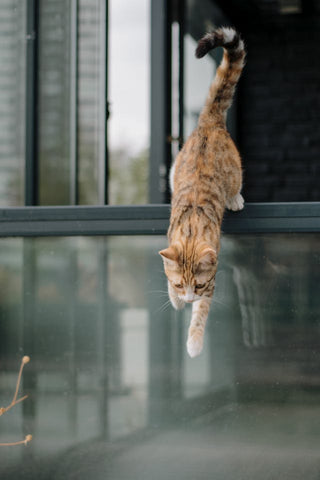
In 1984 two New York Metropolis veterinarians saved observe of 132 instances of cats falling from high-rise buildings, some as excessive as 32 flooring. 90% of the cats of their examine survived.[13]
The vets seen an odd development of their knowledge. The primary half was not shocking: the upper the ground from which the cats fell, the more serious the injury.
However after a sure variety of flooring – seven to be actual – the injury appeared to lower. In different phrases, a cat who fell from the 11th ground would, theoretically, do higher than a cat who fell from the 6th ground.
What might clarify this?
There are theories, together with one involving terminal velocity. As soon as a cat reaches most pace, in accordance with this idea, she’d now not really feel herself accelerating, and she or he would possibly chill out. A relaxed cat would possibly unfold her limbs extra, growing her air resistance and slowing her descent, which might result in less-severe accidents.[14]
However the true reply in all probability has one thing to do with survivorship bias.
This examine was performed by vets who tracked cats delivered to their workplace after a fall. Cats who didn’t survive a fall would by no means have been delivered to a vet’s workplace within the first place. It’s possible there have been extra deaths from larger tales than this examine suggests.

Actually, a later examine of 119 cats confirmed that falls from seven tales or larger was related to extra extreme accidents than falls from decrease flooring.[15]
If nothing else, this subject reminds us how really superb cats actually are, as if any of us cat lovers wanted reminding.
And in addition, to maintain our home windows closed.
Love Pinterest? Here is a Pinterest-friendly pin to your boards!
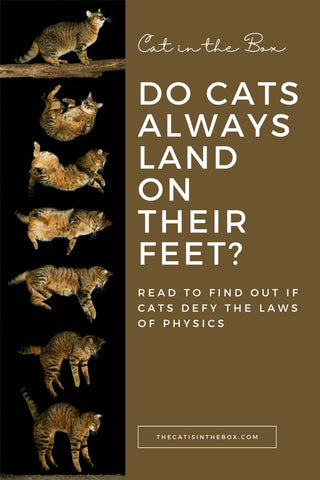
Daybreak LaFontaine is a lifelong animal lover who at all times appears to have somewhat pet hair in her keyboard. Her weblog, Kitty Contemplations, helps cat guardians higher perceive and take care of the particular beings they share their lives and houses with. Her cat-products enterprise, Cat within the Field, sells stunning, well-made, and award-winning merchandise that she designed to fulfill the organic wants of cats.
_______________
FOOTNOTES
[1] “Cat Survives 12-Story Plunge at Manhattan Residence Constructing.” CBS Information, CBS Interactive, 16 Aug. 2014, www.cbsnews.com/newyork/information/cat-survives-12-story-plunge-at-manhattan-apartment-building/.
[2] McDonald, Kassidy. “Alexandria Cat Survives 15-Story Fall.” Alexandria Occasions, 8 Aug. 2022, alextimes.com/2022/08/alexandria-cat-survives-15-story-fall/.
[3] Sheldon, Robert. “What Is Conservation of Angular Momentum?” WhatIs, TechTarget, 1 June 2022, www.techtarget.com/whatis/definition/conservation-of-angular-momentum.
[4] “Do Cats All the time Land on Their Ft?” Purina, www.purina.co.uk/articles/cats/behaviour/common-questions/do-cats-land-on-their-feet. Accessed 1 Mar. 2024.
[5] “Chronophotography.” Wikipedia, Wikimedia Basis, 5 Feb. 2024, en.wikipedia.org/wiki/Chronophotography.
[6] “Vestibular Syndrome.” Cornell College School of Veterinary Medication, 22 Could 2018, www.vet.cornell.edu/departments-centers-and-institutes/cornell-feline-health-center/health-information/feline-health-topics/vestibular-syndrome.
[7] Jusufi A, Zeng Y, Full RJ, Dudley R. Aerial righting reflexes in flightless animals. Integr Comp Biol. 2011 Dec;51(6):937-43. doi: 10.1093/icb/icr114. Epub 2011 Sep 19. PMID: 21930662. https://pubmed.ncbi.nlm.nih.gov/21930662/
[8] Inc, Sanmita. “Residence⁄ Faqs⁄ Why Are Cats so Versatile?” Cornell Middle for Supplies Analysis, www.ccmr.cornell.edu/faqs/why-are-cats-so-flexible/. Accessed 5 Mar. 2024.
[9] Kane, T.R., and M.P. Sher. “A Dynamical Clarification of the Falling Cat Phenomenon.” Worldwide Journal of Solids and Buildings, Pergamon, 29 Oct. 1968, www.sciencedirect.com/science/article/abs/pii/0020768369900869.
[10] Hill, Kyle. “How Do Cats Survive Falls from Nice Heights?” Science, 12 Oct. 2012, sciencebasedlife.wordpress.com/2012/04/13/how-do-cats-survive-falls-from-great-heights/.
[11] “Strain Drive Space.” Third Area Studying, 18 Apr. 2023, thirdspacelearning.com/gcse-maths/ratio-and-proportion/pressure-force-area/.
[12] Hill, Kyle. “How Do Cats Survive Falls from Nice Heights?”
[13] Bischoff, Manon. “Why Do Cats Land on Their Ft? Physics Explains.” Scientific American, 20 Feb. 2024, www.scientificamerican.com/article/why-do-cats-land-on-their-feet-physics-explains/.
[14] “Excessive-Rise Syndrome.” Wikipedia, Wikimedia Basis, 30 Nov. 2023, en.wikipedia.org/wiki/Excessive-rise_syndrome.
[15] Vnuk D, Pirkić B, Matičić D, et al. Feline high-rise syndrome: 119 instances (1998–2001). Journal of Feline Medication and Surgical procedure. 2004;6(5):305-312. doi:10.1016/j.jfms.2003.07.001. https://journals.sagepub.com/doi/10.1016/j.jfms.2003.07.001












